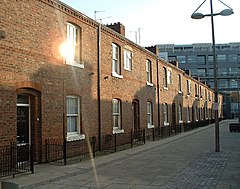Ancoats
| Ancoats | |
|---|---|
 Ancoats is a former industrial district being gentrified as a residential area |
|
| Ancoats shown within Greater Manchester | |
| OS grid reference | SJ847985 |
| Metropolitan borough | |
| Metropolitan county | |
| Region | |
| Country | England |
| Sovereign state | United Kingdom |
| Post town | MANCHESTER |
| Postcode district | M4 |
| Dialling code | 0161 |
| Police | Greater Manchester |
| Fire | Greater Manchester |
| Ambulance | North West |
| EU Parliament | North West England |
Ancoats is an inner city area of Manchester, North West England, next to the Northern Quarter and the northern part of Manchester city centre.
Historically in Lancashire, Ancoats became a cradle of the Industrial Revolution and has been called "the world's first industrial suburb". For many years, from the late 18th century onwards, Ancoats was a thriving industrial district. The area suffered accelerating economic decline from the 1930s and depopulation in the years after the Second World War, particularly during the slum clearances of the 1960s.
Since the 1990s Ancoats' industrial heritage has been recognised and its proximity to the city centre has led to investment and substantial regeneration. The southern region of the suburb is branded as New Islington, by UK property developers Urban Splash, while the north retains the Ancoats name, with redevelopment centred on the Daily Express Building.
For the purpose of local government elections the area is part of the Ancoats and Clayton ward of the city of Manchester.
The name Ancoats is likely to have derived from the Old English ana cots, meaning "lonely cottages". The settlement is first recorded as Elnecot in 1212. In a survey of 1320, Ancoats was recorded as one of the eight hamlets within the township of Manchester in the ancient parish of Manchester within the hundred of Salford; the hamlet probably consisted of a few cottages and farmhouses centred on what is now Ancoats Lane, Butler Lane and Newton Lane. During the medieval period, Ancoats Hall was built. Land in Ancoats was bequeathed in the 14th century by Henry de Ancotes. The village covered the area of land that roughly lies between the River Medlock and the River Irk.
...
Wikipedia

